Coronavirus (COVID-19): modelling the epidemic (issue no.84)
Latest findings in modelling the COVID-19 epidemic in Scotland, both in terms of the spread of the disease through the population (epidemiological modelling) and of the demands it will place on the system, for example in terms of health care requirement.
This document is part of a collection
Coronavirus (COVID-19): modelling the epidemic in Scotland (Issue No. 84)
Background
This is a report on the Scottish Government modelling of the spread and level of Covid-19 in Scotland. This updates the previous publication on modelling of Covid-19 in Scotland published on 23rd December 2021. The estimates in this document help the Scottish Government, the health service and the wider public sector plan and put into place what is needed to keep us safe and treat people who have the virus.
This edition of the research findings focuses on the epidemic as a whole, looking at estimates of R, growth rate and incidence as well as local measures of change in the epidemic. It looks at both the impact of the Delta and Omicron variants.
Key Points
General modelling
- The reproduction rate R in Scotland is currently estimated as being between 1.2 and 1.5, as of 21st December 2021. The lower and upper estimates have increased since last publication.
- The number of new daily infections for Scotland is estimated as being between 237 and 507 as at 21st December, per 100,000 people.
- The daily growth rate for Scotland is currently estimated as between 4% and 9% as at 21st December. The lower and upper limits have increased since last publication.
- Average contacts from the most recent Panel A cohort of the Scottish Contact Survey (week ending 29th December) indicate an average of 5.2 contacts.
- Overall contacts has decreased by 13% compared to the previous Panel A of the survey (week ending 15th December). A similar trend is seen for Panel B in the previous week, decreasing by 21% (comparing week ending 8th and week ending 22nd).
- Mean contacts have decreased within the work and other setting (contacts outside home, school and work) reducing by 26% and 23% respectively. Contacts within the home have increased by 22% over the same period.
- All age groups, with the exception of those aged 18-29, have decreased their contacts. The 18-29 age group have reported an increase of contacts by 21%. This is largely driven by a rise in contacts within the home and work.
- The biggest increase in interactions are reported between those over 50 with individuals within the 18-29 age group in the last two weeks.
- Visits to a pub/restaurant decreased from approximately 49% to 32% and those using public transport decreased from 25% to 15% in the last two weeks. Visits to another's home have reported the biggest increase, rising from 47% to 51% in the last two weeks.
- The number of people wearing a face covering where they have at least one contact outside of the home has decreased in the last two weeks from 87% to 74%.
- Approximately 85% of individuals have taken at least one lateral flow test within the last 7 days for the survey pertaining to the 23rd - 29th December, with 47% of individuals taking at least three.
- Infections, hospitalisations, hospital occupancy and deaths are rising and are expected to continue to rise as Omicron continues to spread; some Delta infections may also continue. We estimate that daily infections may be between 25,000 and 110,000 by mid-January. In two weeks, we estimate that daily hospital admissions will be between 400 and 770, and daily deaths will be between 5 and 92. This includes the impact of the interventions announced on 14th and 21st December, and booster take up.
- Modelled rates of positive tests per 100K using data to 4th January indicate that, for the week commencing 16th January 2022, 29 of the 32 local authorities are expected to exceed 50 cases per 100K with at least 75% probability. 28 of these are expected to exceed 1000 cases per 100K with at least 75% probability and 14 are expected to exceed 3000 cases per 100K with at least 75% probability.
- 3 local authorities are expected to exceed 4000 cases per 100K with at least 75% probability. These are Aberdeen City, North Lanarkshire and South Lanarkshire.
- Nationwide, wastewater Covid-19 RNA levels have shown a large increase during the Christmas period, increasing by approximately 71% in the last week. The week ending on 4th January saw levels in excess of 220 million gene copies per person per day (Mgc/p/d), up from around 130 Mgc/p/d in the previous week. The trend confirms the recent steep rise in cases caused by the rapid spread of Omicron variant, although these results arise from a reduced sampling scheme over the festive period.
- Modelling of long Covid estimates that on 23rd January 2022 between 1.6% and 3.4% of the population are projected to self-classify with long Covid for 12 weeks or more after their first confirmed (or suspected) Covid infection in Scotland. The lower and upper limits of the estimate of the proportion of the population with long Covid are higher than two weeks ago.
Based on the Omicron variant
- Using data to 3rd January 2022, we estimate a doubling time for Omicron in Scotland of between 3.88 – 3.95 days using S-gene target failure as a proxy for Omicron cases.
Recent cases
Figure 1 shows the number of Covid-19 cases reported in Scotland between December 2021 and January 2022. The vertical dashed lines indicate the cut off points for each of the modelling inputs; after these dates, the number of cases is not incorporated into the outputs.
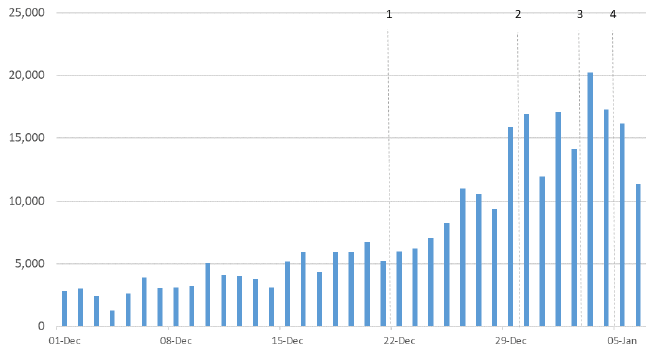
R, growth rate and incidence are as of 21st December (dashed line 1). The Scottish Contact Survey uses data to 29th December (dashed line 2). The Scottish Government modelling of infections and the long Covid analysis use data to 2nd January (dashed line 3). Wastewater analysis and the modelled rates of positive tests per 100K use data to 4th January (dashed line 4).
As reported on 5th January 2022, 91.1% of all PCR tests from Pillar 2 Lighthouse Labs had the S-gene target failure, used as a proxy for Omicron cases[1]. Therefore we are not providing a chart of Omicron cases this week.
Overview of Scottish Government Modelling
Modelling outputs are provided here on the current epidemic in Scotland as a whole, based on a range of methods. Because it takes a little over three weeks on average for a person who catches Covid-19 to show symptoms, become sick, and either die or recover, there is a time lag in what our model can tell us about any change in the epidemic.
General modelling
The R value and growth rates are estimated by several independent modelling groups based in universities and the UKHSA. Estimates are considered, discussed and combined at the Epidemiology Modelling Review Group (EMRG), which sits within the UKHSA. These are based on data to 4th January.
UKHSA's consensus view across these methods, was that the value of R as at 21st December[2] in Scotland was between 1.2 and 1.5 (see Figure 3)[3].
R is an indicator that lags by two to three weeks and therefore should not be expected to fully reflect the increased prevalence of Omicron in recent weeks.
This week the Scottish Government presented one output to EMRG. This used wastewater data to estimate the number of cases.
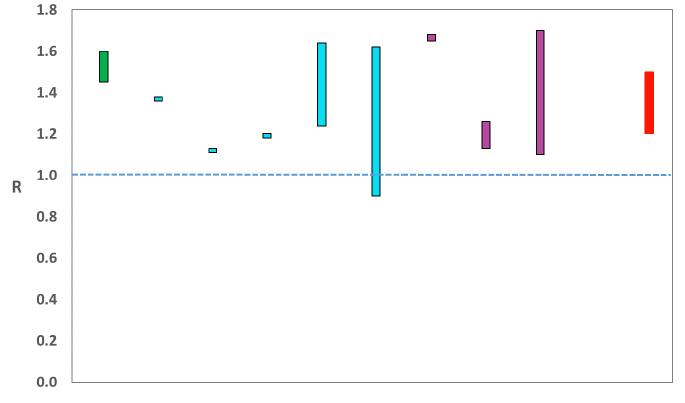
Source: EMRG
The various groups which report to the EMRG use different sources of data in their models to produce estimates of incidence (Figure 4). UKHSA's consensus view across these methods, as at 21st December, was that the incidence of new daily infections in Scotland was between 237 and 507 new infections per 100,000. This equates to between 13,000 and 27,700 people becoming infected each day in Scotland.
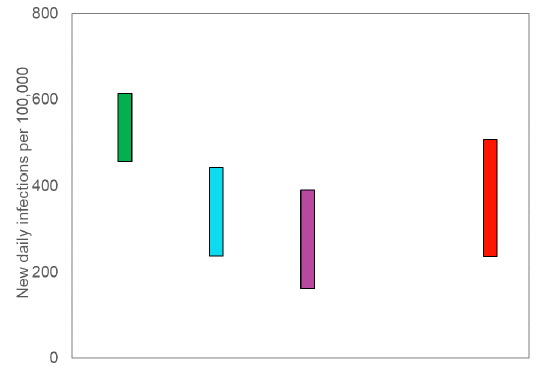
Source: EMRG
The consensus from UKHSA for this week is that the growth rate in Scotland is between 4% and 9% per day as at 21st December. The lower and upper limits have increased since last publication.
What we know about how people's contact patterns have changed
Two new surveys have been created from a recent recruitment and ran alongside current established panels A & B from 25th November 2021. The new panels have been combined with the established panels to maintain numbers and demographic representation. Further details of this are presented in the Technical Annex.
Average contacts from the most recent Panel A cohort of the Scottish Contact Survey (week ending 29th December) indicate an average of 5.2 contacts. This has decreased by 13% compared to the previous Panel A of the survey (week ending 15th December). A similar trend is seen for Panel B in the previous week, decreasing by 21% (comparing weeks ending 8th and 22nd December) shown in Figure 5. Mean contacts have decreased within the work and other setting (contacts outside home, school and work) reducing by 26% and 23% respectively. Contacts within the home have increased by 22% over the same period.
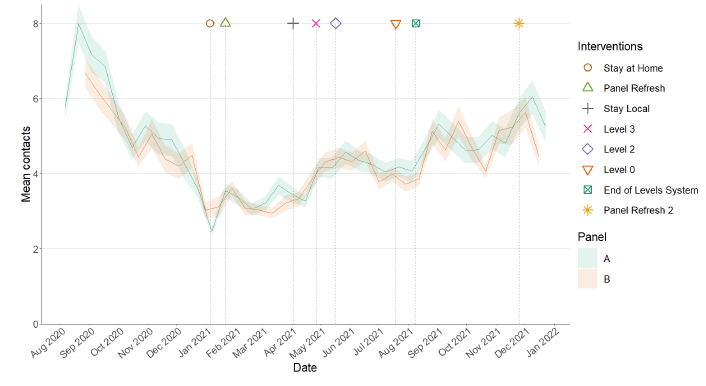
Figure 6 shows how contacts change across age group and setting. All age groups, with the exception of those aged 18-29, have decreased their contacts. The 18-29 age group have reported an increase of contacts by 21%. This is largely driven by a rise in contacts within the home and work.
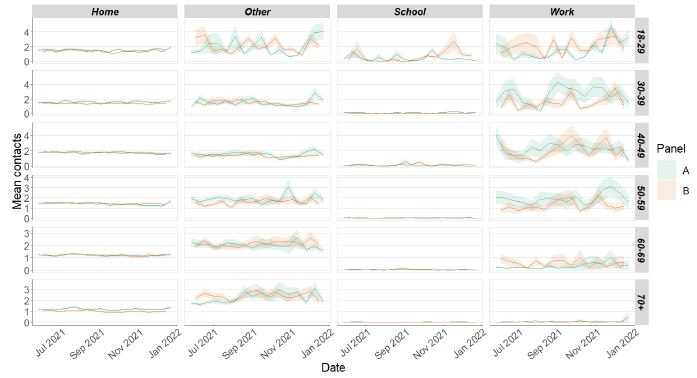
The heatmaps in Figure 7 show the mean overall contacts between age groups for the weeks relating to 9th December - 15th December and 23rd December - 29th December and the difference between these periods. The biggest increase in interactions are reported between those over 50 with individuals within the 18-29 age group in the last two weeks.
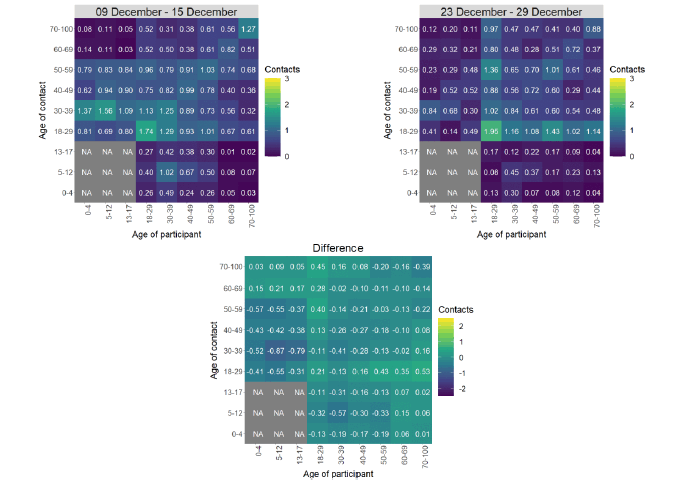
As shown in Figure 8, the biggest decrease in the proportion of participants visiting different locations is seen in those visiting a pub/restaurant and those using public transport. Visits to a pub/restaurant decreased from approximately 49% to 32% and those using public transport decreased from 25% to 15% in the last two weeks. Visits to another's home have reported the biggest increase, rising from 47% to 51% in the last two weeks.
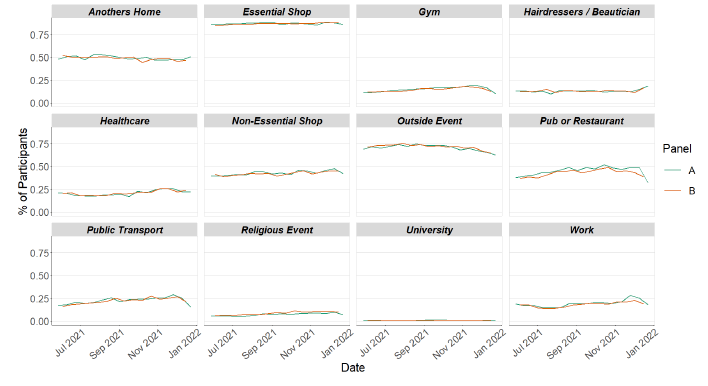
Figure 9 shows the number of people wearing a face covering where they have at least one contact outside of the home. This has decreased in the last two weeks from 87% to 74%.
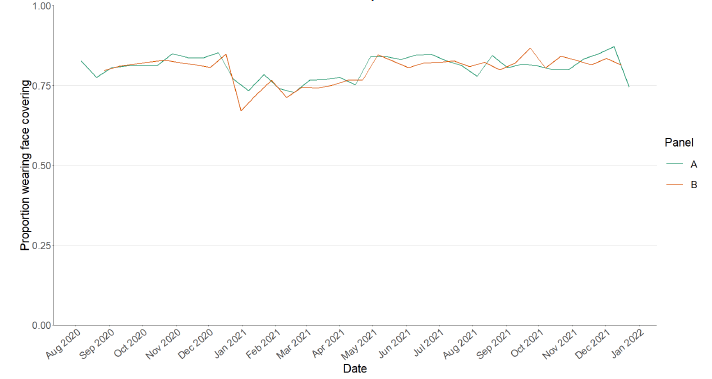
Approximately 85% of individuals have taken at least one lateral flow test within the last 7 days for the survey pertaining to the week ending 29th December, with 47% of individuals taking at least three as shown in Figure 10.
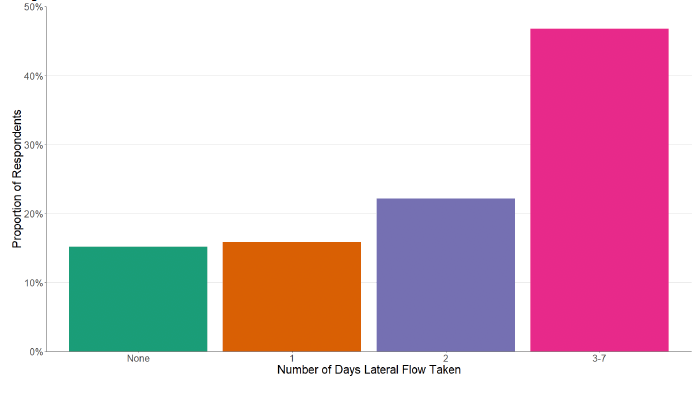
The youngest and oldest age groups (18-29 and 70+) have reported the lowest proportions of individuals who have taken one or more lateral flows, 76% and 81% respectively. In contrast, those aged between 30‑69 report the highest proportion of individuals taking at least one lateral flow test within the last 7 days, with at least 86% taken a minimum of one.
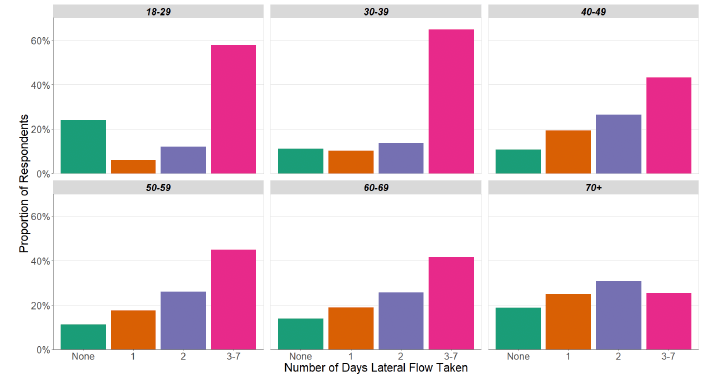
How do contact patterns compare against the festive period in 2020?
In November 2020 average contacts were 16% higher than those reported in November 2021 with contacts within the work setting largely driving this increase as show in Table 1.
During December, average contacts are at a similar level for 2020 and 2021. However, there are difference in contact levels within the settings over the two years. The highest number of contacts across settings in 2020 was within the workplace, whereas in 2021 the highest number of contacts were reported in the other setting.
| All | Work | Other | Home | |
|---|---|---|---|---|
| November 2020 | 4.9 | 1.9 | 1.4 | 1.4 |
| November 2021 | 4.1 | 1.3 | 1.3 | 1.4 |
| December 2020 | 5.2 | 1.9 | 1.7 | 1.4 |
| December 2021 | 5.3 | 1.5 | 2.2 | 1.4 |
Interactions in November and December 2021 for those in the 18-29 age group are higher than those reported in the same months for 2020, with interactions almost double between the 18-29s and all age groups in December 2021 compared to December 2020 as seen in Figure 12.
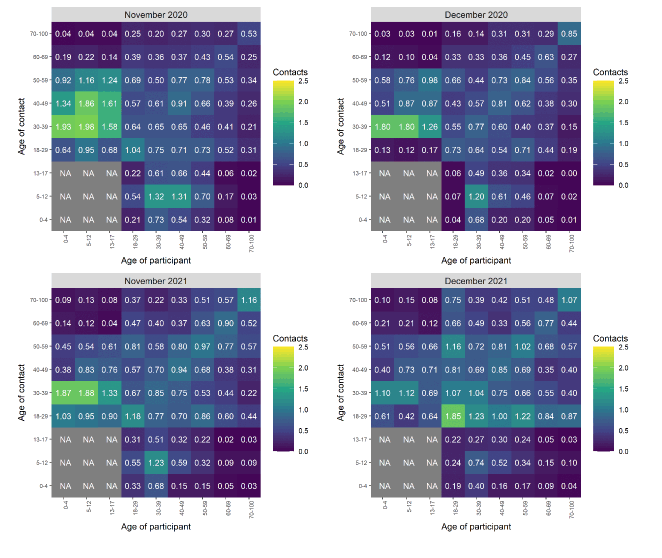
What the modelling tells us about estimated infections
The Scottish Government assesses the impact of Covid-19 on the NHS in the next few weeks, in this research findings we focus on estimating the number of infections. Figure 10 show projections over the four weeks for combined Delta and Omicron infections.
These projections include the effect of the interventions announced on 14th and 21st December, and booster take up. 'Central' assumes a continuation of the current trend for Delta, and that Omicron is between two to three times more transmissible. 'Worse' assumes a higher transmissibility for both Delta and Omicron. 'Better' assumes a lower transmissibility for both variants. All projections also assume a lower vaccine effectiveness[5] for Omicron than for Delta[6].
Delta infections are likely to fall over time based on the current level of restrictions, but those still being infected and already infected will still contribute to the numbers of people in hospital and ICU. Meanwhile the increase which we see in Omicron infections will continue. Infection figures are provided in Figure 13.
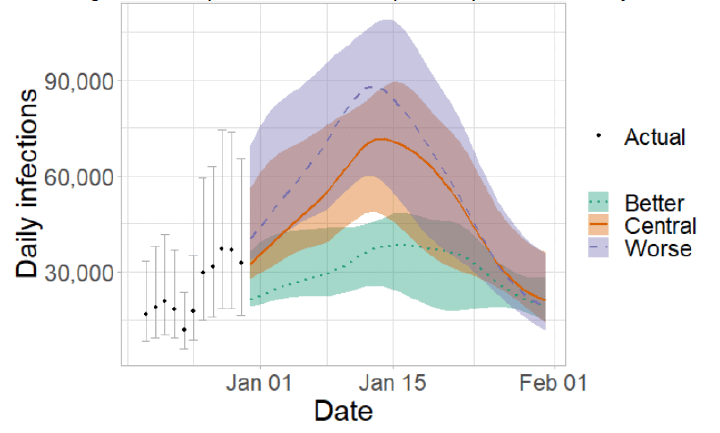
What the modelling tells us about projections of hospitalisations and deaths in the medium term
SPI-M-O produces projections of the epidemic (Figures 14 and 16), combining estimates from several independent models. These projections are not forecasts or predictions. They represent a scenario in which the trajectory of the epidemic continues to follow the trends that were seen in the data available to 4th January and do not include the effects of any future policy or behavioural changes.
Disruption to data flows and increased reporting delays over the festive period makes it difficult to interpret recent trends in the data. Revisions made to the data streams after 4th January will not be reflected in these projections.
The delay between infection, developing symptoms, the need for hospital care, and death means they cannot fully reflect the impact of behaviour changes in the two to three weeks prior to either the 31st December or 4th January.
The projections include the potential impact of vaccinations over the next few weeks. Modelling groups have used their expert judgement and evidence from UKHSA, Scottish Universities & Public Health Scotland, and other published efficacy studies when making assumptions about vaccine effectiveness.
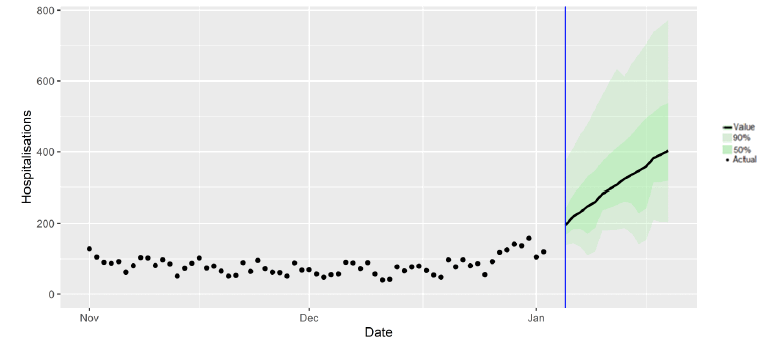
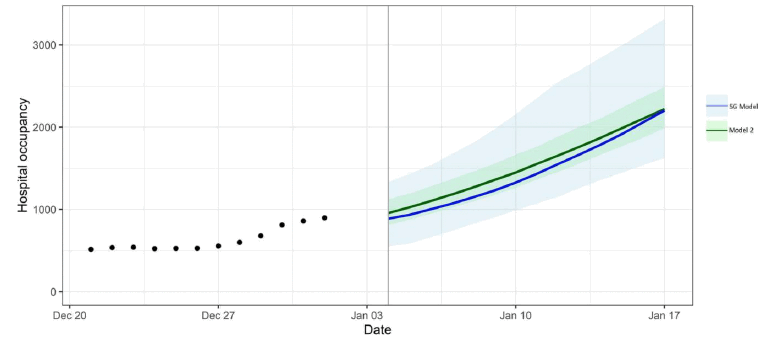
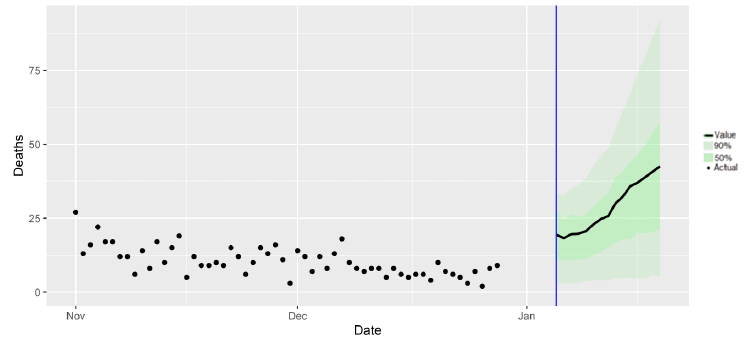
What we know about which local authorities are likely to experience high levels of Covid-19 in two weeks' time
We continue to use modelling based on Covid-19 cases and deaths using data to 4th January from several academic groups to give us an indication of whether a local authority is likely to experience high levels of Covid-19 in the future. This has not been compiled via UKHSA into a consensus this week and is based on one modelling group. Due to the Christmas period, there is increased uncertainty due to differences in case reporting. Typically across the regions, case numbers have been lower over Christmas, and have increased sharply since. These trends have been detected to varying degrees by the model.
In this, an area is defined as a hotspot if the two week prediction of cases (positive tests) per 100K population is predicted to exceed a threshold, e.g. 500 cases.
Modelled rates of positive tests per 100K using data to 4th January indicate that, for the week commencing 16th January 2022, 29 of the 32 local authorities are expected to exceed 50 cases per 100K with at least 75% probability. The exceptions are Na h‑Eileanan Siar, Orkney Islands and Shetland. These 29 areas are also expected to exceed 500 cases per 100K with at least 75% probability.
28 local authorities are expected to exceed 1000 cases per 100K with at least 75% probability. These are Aberdeen City, Aberdeenshire, Angus, City of Edinburgh, Clackmannanshire, Dumfries and Galloway, Dundee City, East Ayrshire, East Dunbartonshire, East Lothian, East Renfrewshire, Falkirk, Fife, Glasgow City, Highland, Inverclyde, Midlothian, Moray, North Ayrshire, North Lanarkshire, Perth and Kinross, Renfrewshire, Scottish Borders, South Ayrshire, South Lanarkshire, Stirling, West Dunbartonshire and West Lothian.
14 local authorities are expected to exceed 3000 cases per 100K with at least 75% probability. These are Aberdeen City, Dumfries and Galloway, Dundee City, East Ayrshire, East Dunbartonshire, Falkirk, Glasgow City, Highland, Inverclyde, North Lanarkshire, Perth and Kinross, Renfrewshire, Scottish Borders and South Lanarkshire.
3 local authorities are expected to exceed 4000 cases per 100K with at least 75% probability. These are Aberdeen City, North Lanarkshire and South Lanarkshire.
Figure 17 shows the estimate of cases for each local authority in Scotland. The boxes show the interquartile range (50th confidence interval) and the whiskers show the 5th and 95th percentile points.
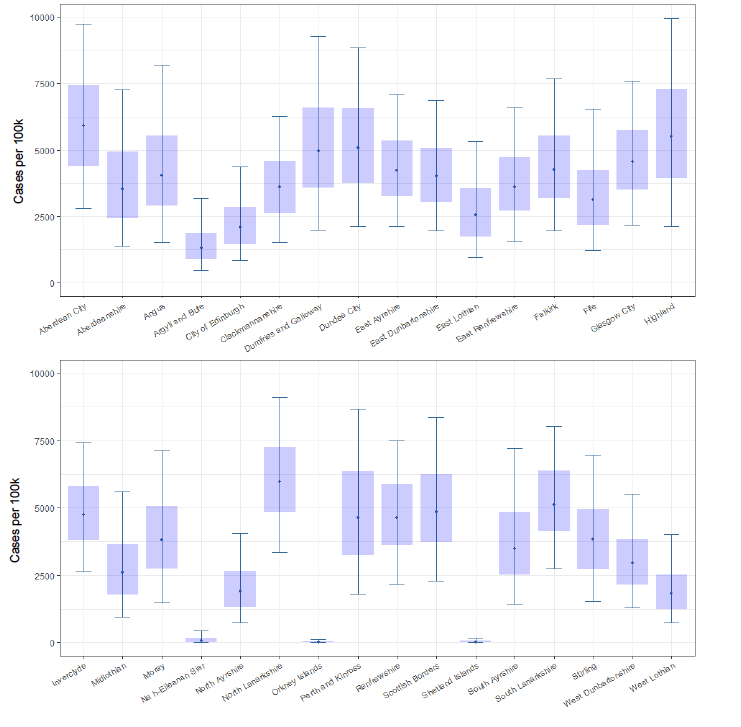
What can analysis of wastewater samples tell us about local outbreaks of Covid-19 infection?
Levels of COVID-19 RNA in wastewater (WW) collected at a number of sites around Scotland are adjusted for population and local changes in intake flow rate (or ammonia levels where flow is not available) and compared to 7-day average daily new case rates derived from Local Authority and Neighbourhood (Intermediate Zone) level aggregate data. See Technical Annex in Issue 34 of these Research Findings for the methodology.
Nationwide, wastewater Covid-19 RNA levels have shown a large increase during the festive period. The week ending on 4th January saw levels in excess of 220 million gene copies per person per day (Mgc/p/d), up from around 130 Mgc/p/d in the week ending on 21st December, and 67 Mgc/p/d in the previous reported week ending 14th December, an increase of 71%. The trend confirms the recent steep rise in cases caused by the rapid spread of Omicron variant, although these results arise from a reduced sampling scheme over the festive period.
Figure 18 shows the national average trend for the full set of sampled sites, with a small number of unrealistically large outliers excluded[9].
WW Covid-19 levels have increased. Though wastewater Covid-19 increases are in line with the increase in case rates up until the new year, the additional increase in cases afterwards has not appeared in the WW dataset. The significance of this is difficult to gauge due to the rapidity of changes and the small number of samples and sampling dates.
The bulk of the increase for both cases and wastewater took place after the most recently available ONS Coronavirus Infection Survey data (16th December) which is also shown in Figure 17 with the different datasets being broadly in line up to that point. Due to the reduced level of sampling, coverage for many Health Boards and Local Authorities is lower than usual, with many having none.
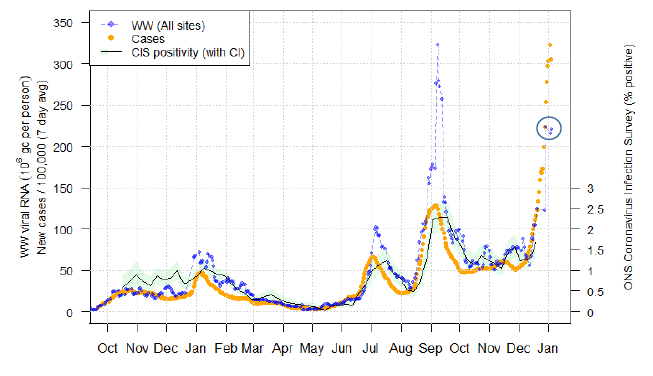
What estimates do we have of the number of people experiencing long Covid symptoms?
The Scottish Government is modelling the number of people likely to experience long Covid symptoms. This gives a projection of estimated self-reported long Covid rates in the future, based on Scottish Government medium term projection modelling, as set out in Figure 19.
This modelling estimates that at 23rd January 2022 between 85,000 (1.6% of the population) and 187,000 (3.4%) people are projected to self-classify with long Covid for 12 weeks or more after their first suspected Covid infection in Scotland.
These are preliminary results, further data on rates of long Covid and associated syndromes as research emerges are required.
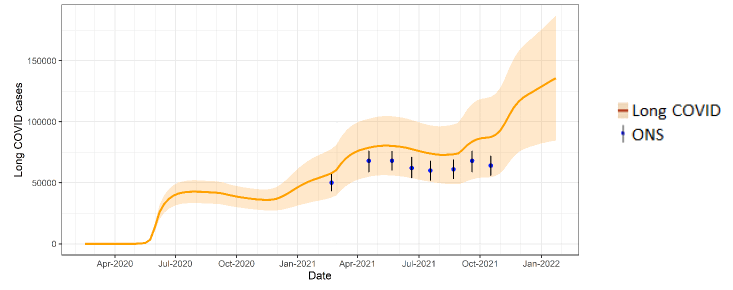
See the Technical Annex in issue 73 for information about the methodology.
What we know about the Omicron variant
91.1% of all PCR tests from Pillar 2 Lighthouse Labs had the S-gene target failure, as reported on 5 January 2022[11]. S-gene target failure is used as a proxy for Omicron cases.
Using data to 3rd January, we estimate a doubling time for Omicron in Scotland to be between 3.88 – 3.95 days using S-gene target failure as a proxy for Omicron cases.
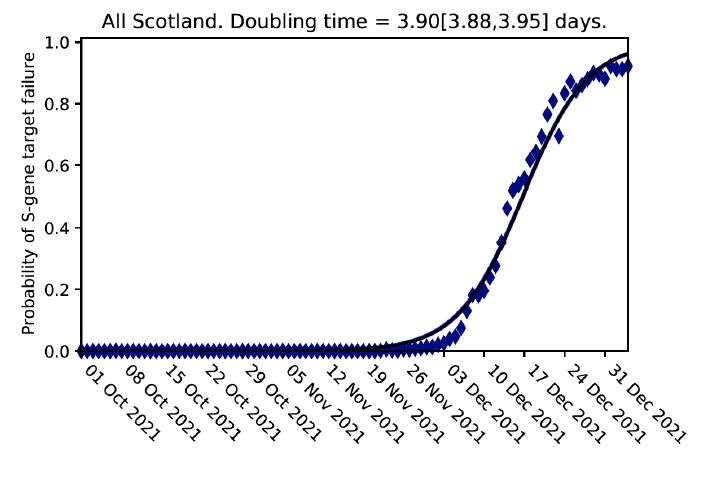
Figure 21 shows how our estimate of doubling time of Omicron, based on this methodology, has changed over time. A longer doubling time means that the virus is continuing to grow but is transmitting more slowly than previously. However this is still lower than the estimated doubling time of Delta[12].
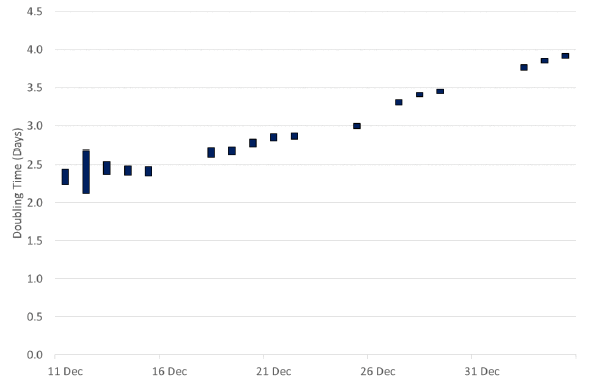
Note that this calculation has not been done every day as it includes weekends and days over the festive period.
See the Technical Annex in Issue 82 for information about the methodology.
What next?
Modelling will be provided for both the Delta and Omicron variants where possible. As more information on Omicron becomes available this will be incorporated in the different models as and when it is appropriate to do so.
Contact
There is a problem
Thanks for your feedback